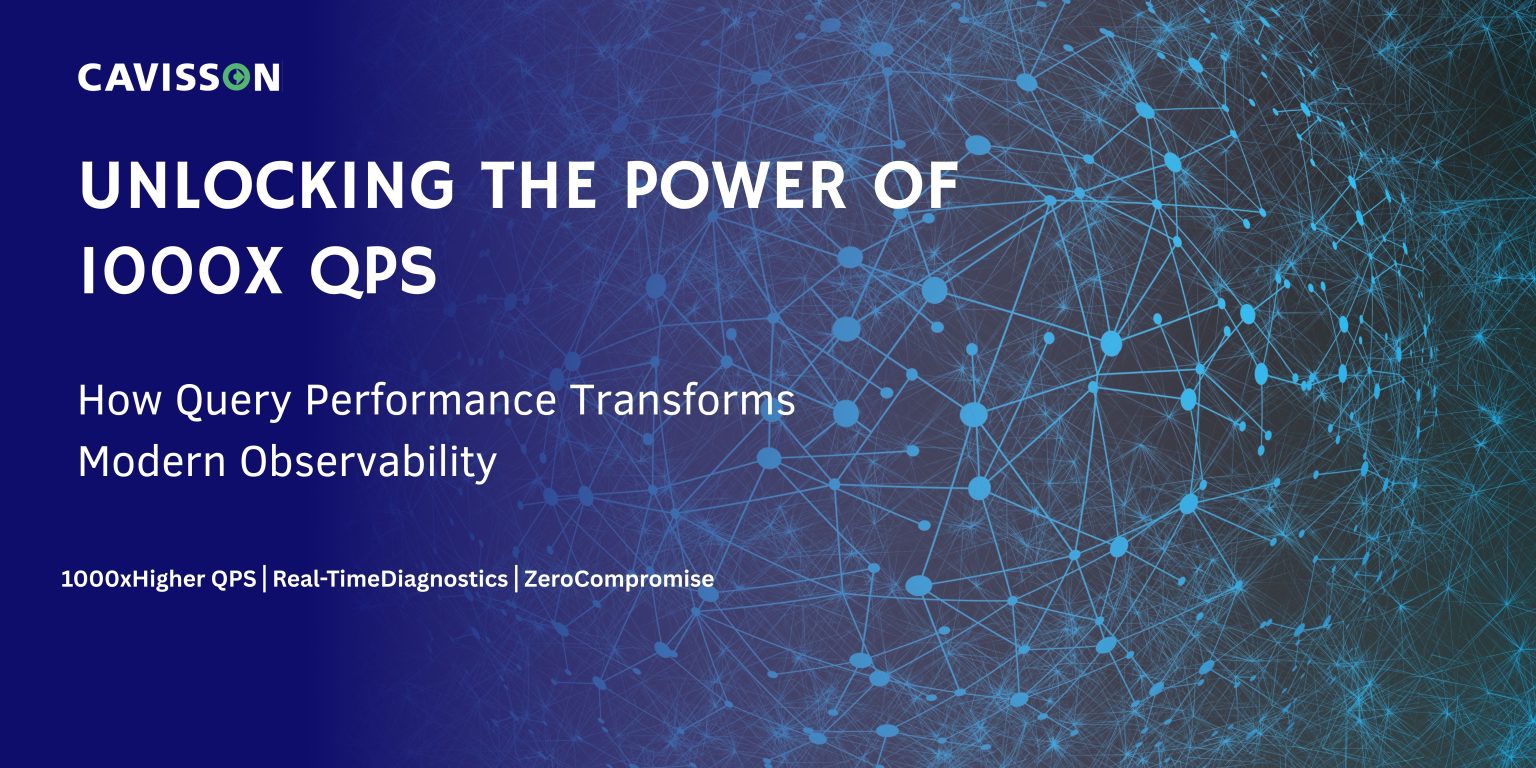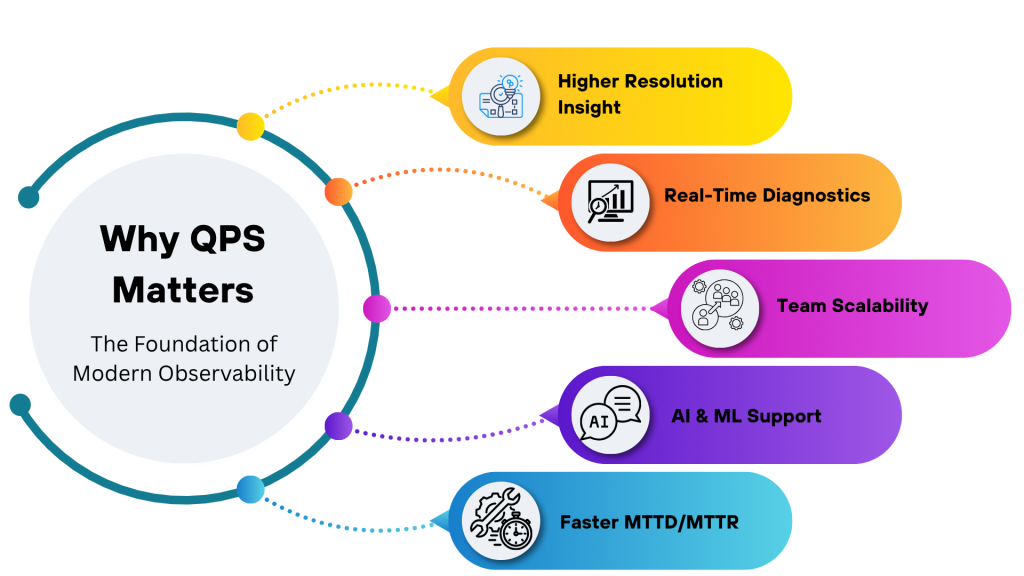
Understanding QPS: More Than Just Speed
Query Per Second (QPS) represents the number of database or system queries that can be executed within a single second. While this might sound like a simple performance metric, QPS fundamentally determines how deeply and frequently your teams can interact with your observability data. It’s the difference between reactive monitoring and proactive system intelligence.Why QPS Matters: The Foundation of Modern Observability

1. Higher Resolution Insights (Granularity)
More QPS means more queries per unit of time, enabling you to slice data more finely—e.g., instead of looking at a metric every 10 seconds, you can examine it every 10 milliseconds. This leads to faster detection of anomalies, spikes, or regressions.
When your observability platform can handle thousands of queries per second, your engineering teams gain the ability to zoom into system behavior with microscopic precision. This granular visibility becomes crucial during incident response, when every millisecond of delay in identifying root causes directly impacts customer experience.
2. Real-Time Diagnostics
High QPS enables low-latency querying, which is essential for real-time dashboards and on-call incident response. Engineers can run multiple ad-hoc queries without worrying about tool slowdowns.
Imagine debugging a critical production issue where your monitoring dashboard updates in real-time, allowing you to correlate events across multiple services instantaneously. This isn’t just convenience—it’s the difference between resolving an incident in minutes versus hours.
3. Scalability Across Services and Teams
In large organizations with thousands of microservices, high QPS supports concurrent observability workflows by multiple users and systems (dashboards, alerts, AIOps agents, etc.).
Modern enterprises operate complex distributed architectures where dozens of engineering teams need simultaneous access to observability data. Traditional platforms often buckle under this concurrent load, forcing teams to queue their investigations or work with stale data. High QPS eliminates these bottlenecks entirely.
4. Support for Automated Systems (AIOps/ML)
ML models or agentic AI systems that continuously query and reason over observability data need non-human QPS at scale. This is key for autonomous root cause analysis, optimization, and incident resolution.
The future of observability is autonomous. AI-driven systems need to continuously analyze patterns, detect anomalies, and even resolve issues without human intervention. This requires query volumes that far exceed human capacity, often thousands of queries per second to maintain comprehensive system awareness.
5. Faster MTTD/MTTR
Being able to query more often and more deeply speeds up Mean Time to Detect (MTTD) and Mean Time to Resolve (MTTR)—which directly impacts uptime, SLAs, and customer satisfaction.
Every minute of downtime costs businesses thousands of dollars and erodes customer trust. High QPS directly translates to faster incident detection and resolution, protecting both revenue and reputation.
What 1000x Higher QPS than Competitors Enables
◈ Always-On, Real-Time Observability at Scale
You can query across all services, regions, and timeframes continuously without sampling or aggregation. Competitors may need to downsample or delay data to stay performant.
Traditional observability platforms force compromises—either you get real-time data for a limited subset of your infrastructure, or comprehensive coverage with significant delays. Cavission Systems eliminates this false choice, delivering both breadth and immediacy.
◈ Full-Fidelity, Ad-Hoc Analytics
Engineers can drill down instantly from high-level alerts to raw logs/metrics/traces without lag or query failures. It enables exploratory debugging without compromising performance or query limits.
The best debugging sessions are exploratory—following leads, testing hypotheses, and diving deep into unexpected correlations. High QPS makes this natural investigative process possible without the friction of slow queries or system timeouts.
◈ Proactive Issue Prediction
With more frequent and richer queries, the system can detect patterns and early signals of degradation or failure before they impact users.
Prevention is always better than a cure. When your observability platform can continuously analyze system behavior at high frequency, it can identify subtle patterns that precede major incidents, enabling proactive intervention before customer impact occurs.
◈ No Trade-Off Between Cost and Depth
Many observability platforms force customers to choose between cost and detail (e.g., sampling, retention limits). At 1000x QPS, you can offer rich, always-available telemetry without compromise.
Traditional platforms often require expensive trade-offs—retain more data and pay exponentially more, or sample aggressively and risk missing critical events. Our high QPS architecture changes this paradigm entirely, making comprehensive observability economically viable.
The Cavission Systems Advantage
At Cavission Systems, we’ve built our platform from the ground up to deliver this transformative query performance. Our architecture doesn’t just handle high QPS—it thrives under the intense query loads that modern observability demands.
Whether you’re running a startup with ambitious growth plans or managing enterprise infrastructure at scale, the ability to query your observability data without limits fundamentally changes how your teams operate. It transforms observability from a reactive tool into a proactive competitive advantage.
The question isn’t whether you need high QPS observability—it’s whether you can afford to operate without it. In an era where system reliability directly translates to business success, the platforms that enable the deepest, fastest insights will define the winners and losers in the digital economy.
Ready to experience the power of 1000x QPS? Contact Cavission Systems today to see how our next-generation observability platform can transform your engineering team’s capabilities.

